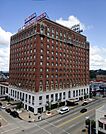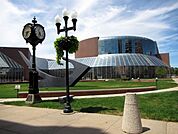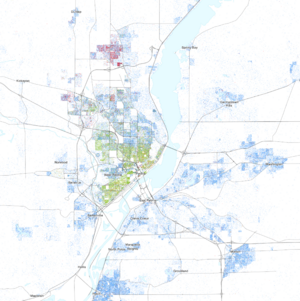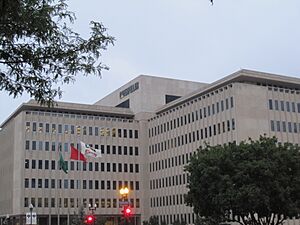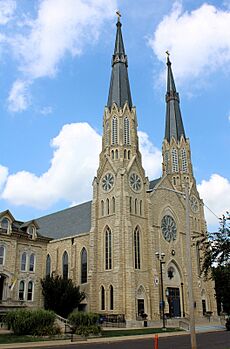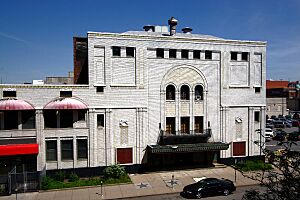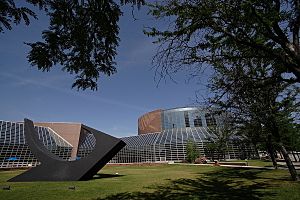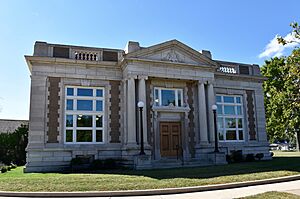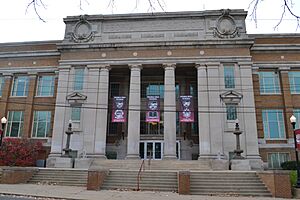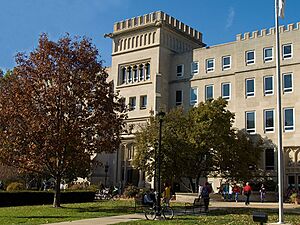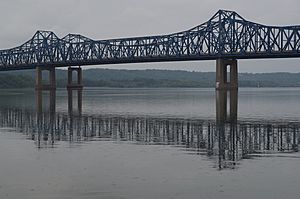Peoria, Illinois facts for kids
Quick facts for kids
Peoria
|
|||
|---|---|---|---|
|
|
|||
|
|||
| Country | |||
| State | |||
| County | Peoria | ||
| Townships | Peoria City, Richwoods, West Peoria | ||
| Settled | 1691 | ||
| Incorporated Town | 1835 | ||
| Incorporated City | 1845 | ||
| Named for | Peoria people | ||
| Government | |||
| • Type | Council-Manager | ||
| Area | |||
| • City | 50.55 sq mi (130.93 km2) | ||
| • Land | 47.97 sq mi (124.24 km2) | ||
| • Water | 2.58 sq mi (6.69 km2) | ||
| Elevation | 502 ft (153 m) | ||
| Population
(2020)
|
|||
| • City | 113,150 (8th in Illinois) | ||
| • Density | 2,359/sq mi (911/km2) | ||
| • Urban | 259,781 (US: 156th) | ||
| • Urban density | 1,781.9/sq mi (688.0/km2) | ||
| • Metro | 402,391 (US: 138th) | ||
| Demonym(s) | Peorian | ||
| Time zone | UTC−6 (CST) | ||
| • Summer (DST) | UTC−5 (CDT) | ||
| ZIP Codes |
29 total ZIP Codes:
61601–61607, 61612–61615, 61625, 61629, 61630, 61633, 61634, 61636–61639, 61641, 61643, 61650–61656
|
||
| Area code(s) | 309 | ||
| FIPS code | 17-59000 | ||
Peoria (/piˈɔːriə/ PEE-or-EE-ə) is a city in Illinois, USA. It is the main city of the Peoria County. Peoria is located on the Illinois River. About 113,150 people lived there in 2020. This makes it the eighth-largest city in Illinois. It is the biggest city in the Peoria metropolitan area. This area includes six counties and has over 402,000 people.
French explorer Henri de Tonti founded Peoria in 1691. This makes it the oldest European settlement in Illinois. It was first called Fort Clark. The city got its current name in 1825. It was named after the Peoria people, a Native American tribe. In 1854, Abraham Lincoln gave a famous speech in Peoria. Before Prohibition, Peoria was a major center for making whiskey. Many distilleries operated here.
Peoria is an important port on the Illinois River. It is a center for trade and shipping farm products. These products include corn, soybeans, and livestock. The city also has many factories. They make things like earthmoving equipment, metal products, and farm tools. Until 2018, Caterpillar Inc., a huge equipment company, had its main office here.
You might have heard the phrase "Will it play in Peoria?" This phrase means if something is popular in Peoria, it will be popular everywhere. It might have started during the vaudeville era. Peoria has several museums. These include the Peoria Riverfront Museum and the Peoria Playhouse Children's Museum.
Contents
- Exploring Peoria's Past: A Look at History
- Peoria's Location and Climate
- Who Lives in Peoria? A Look at Population
- Peoria's Economy: How People Make a Living
- Arts and Culture in Peoria
- Sports in Peoria
- Parks and Recreation in Peoria
- Education in Peoria
- Media and News in Peoria
- Getting Around Peoria: Transportation
- Famous People from Peoria
- Sister Cities
- See also
Exploring Peoria's Past: A Look at History
Peoria is the oldest European settlement in Illinois. Explorers first came up the Illinois River in the late 1600s. In 1680, French explorers René-Robert Cavelier, Sieur de La Salle and Henri de Tonti built Fort Crevecoeur. This fort later burned down. In 1813, Fort Clark was built. When Peoria County was formed in 1825, Fort Clark was officially named Peoria.
The city was named after the Peoria tribe. They were part of the Illinois Confederation. The meaning of the word "Peoria" is not fully known. Some think it means "to dream with the help of a spirit." Peoria became a village on March 11, 1835. It became a city on April 21, 1845.
Did you know that Peoria, Arizona, was named after Peoria, Illinois? Two men from Peoria, Illinois, founded it in 1890. Peoria was also a big deal in bicycle racing in the late 1800s. Famous racer Marshall "Major" Taylor called Peoria the "Mecca" for the sport.
Famous comedian Richard Pryor started his career in Peoria in the 1960s. In 2021, Rita Ali made history. She became Peoria's first female and first African American mayor.
Key Moments in Peoria's History
- 1813: The Peoria War took place from September 19 to October 21.
- 1844: Abraham Lincoln visited Peoria for a court case.
- 1926: Charles Lindbergh started his first air mail route from Chicago, stopping in Peoria. He later thought about his famous flight after taking off from Peoria.
- 1942: The fungus used to make penicillin was found in a moldy cantaloupe in a Peoria grocery store. This helped mass-produce the medicine.
- 1910: Local legend says Theodore Roosevelt called Grandview Drive "the world's most beautiful drive." This street overlooks the Illinois River.
Peoria's Location and Climate
Peoria covers about 50 square miles. Most of this area is land, with a small part being water.
What's the Weather Like in Peoria?
Peoria has a climate with cold, snowy winters. Summers are hot and humid. Temperatures usually range from about 22°F in January to 75°F in July. It snows in winter, but the amount changes each year. Rain is heaviest in spring and summer. The lowest temperature ever recorded was -27°F in January 1884. The highest was 113°F in July 1936.
Who Lives in Peoria? A Look at Population
In 2020, Peoria had 113,150 people. The city is home to people from many different backgrounds. About 53% of the people were White. About 27% were Black or African American. About 6% were Asian. About 7% were Hispanic or Latino.
In 2010, there were 115,021 people living in Peoria. About 29% of households had children under 18. The average household had 2.39 people. The median age in the city was 34 years old.
Peoria's Economy: How People Make a Living
Peoria's first big industry was a flour mill in 1830. Later, pork processing started. Many other businesses grew slowly. These included carriage factories and pottery makers. Peoria became a world leader in distilleries. Between 1837 and 1919, there were over 24 distilleries and 73 breweries.
Farm machinery manufacturing also began early. Companies like Kingman Plow Co. and Avery Manufacturing Co. were important. In 1889, Keystone Steel & Wire started making the first wire fences.
In the 1880s, bicycle companies like Rouse Hazard Co. were big. Charles Duryea even made the first gasoline-powered car in the U.S. in 1893. As farming equipment slowed down, earthmoving and tractor companies grew. In 1925, Caterpillar Tractor Co. was formed. This company became a world leader in heavy equipment. Caterpillar's main office moved from Peoria in 2017. However, it is still a very important employer in the city.
Health care is now a huge part of Peoria's economy. In 2021, Peoria was ranked as the sixth-best midsize healthcare city in the country. OSF HealthCare is the city's top employer. It has its main office in Peoria. They opened a new $250 million Cancer Institute in 2024. This also includes the Children's Hospital of Illinois. Carle Health also runs two hospitals in the city.
The National Center for Agricultural Utilization Research is in Peoria. This is a large research facility. Scientists here helped develop the mass production of penicillin.
Where to Shop in Peoria
Northwoods Mall is the biggest shopping mall in the area. Other shopping centers include The Shoppes at Grand Prairie and Junction City.
Major Businesses in Peoria
Many important businesses and organizations are in Peoria:
- Caterpillar Inc.: A huge company that makes heavy equipment.
- CEFCU: A credit union started by Caterpillar employees.
- Komatsu America Corporation: A top maker of mining equipment.
- Maui Jim: A company that makes sunglasses.
- National Center for Agricultural Utilization Research: A large USDA research lab.
- OSF Healthcare: Operates OSF Saint Francis Medical Center.
- RLI Corp.: A specialty insurance company.
- Carle Health: Operates two hospitals in the city.
Top Employers in the City
Here are some of the biggest employers in Peoria:
| # | Employer | # of Employees |
|---|---|---|
| 1 | OSF Healthcare | 12,000 |
| 2 | Caterpillar Inc | 10,500 |
| 3 | Carle Health | 5,200 |
| 4 | Peoria Public Schools District 150 | 2,675 |
| 5 | Vonachen Services, Inc. | 1,200 |
| 6 | Bradley University | 1,200 |
| 7 | Komatsu Limited | 912 |
| 8 | GFL Environmental | 888 |
| 9 | Citizens Equity First Credit Union | 875 |
| 10 | City of Peoria | 850 |
Arts and Culture in Peoria
Peoria has many places to explore art and culture.
Museums to Visit
You can visit the Pettengill–Morron House and the John C. Flanagan House Museum. Both are managed by the Peoria Historical Society. The Wheels O' Time Museum is also nearby.
The Museum Block opened in 2012. It has the Peoria Riverfront Museum and The Caterpillar Experience. This visitor center shows Caterpillar's past, present, and future. The Peoria PlayHouse Children's Museum opened in 2015.
Fun Festivals and Events
The Heart of Illinois Fair has been held every year since 1949. The Steamboat Classic is a large running race held every summer. The Peoria Santa Claus Parade started in 1888. It is the oldest running holiday parade in the United States.
The Peoria Art Guild hosts an Annual Art Fair. It is one of the top art fairs in the country. The Peoria Park District also helps host many other festivals. These include Fiesta en el Rio, Peoria Irish Fest, and Oktoberfest.
Performing Arts Scene
The Peoria Symphony Orchestra is one of the oldest in the nation. Peoria also has the Peoria Municipal Band and the Youth Music Illinois. The Peoria Players is one of the oldest community theaters in the U.S. Corn Stock Theatre is an outdoor theater company.
The Heart of Illinois Fair also features livestock shows, rides, and concerts.
Peoria Civic Center
The Peoria Civic Center opened in 1982. It has an arena, a convention center, and a theater. It was updated in 2007. The Hotel Pere Marquette is connected to the Civic Center. The Civic Center hosts many events. These include Bradley Braves men's basketball games and the IHSA State Chess Championship. The chess tournament is one of the largest team chess events in the U.S.
Peoria Public Library
Library services in Peoria began in 1855. The Peoria Public Library now has five locations. This includes the Main Library and the historic Lincoln Branch.
Sports in Peoria
Peoria has several sports teams:
| Club | League | Sport | Venue | Established | Championships |
|---|---|---|---|---|---|
| Peoria Chiefs | Midwest League | Baseball | Dozer Park | 1983 | 1 (2002) |
| Peoria Rivermen | SPHL | Ice Hockey | Carver Arena | 1982 | 5 (1985, 1991, 2000, 2022, 2024) |
| Peoria Mustangs | NA3HL | Ice Hockey | Owens Center | 2000 | 0 |
| Peoria City | USL League Two | Association football | Shea Stadium (Peoria, Illinois) | 2020 | 0 |
| Peoria Piggies
(Rugby Football Club) |
D4 Midwest League | Rugby | Catholic Charities | 1958 | 0 |
| Peoria Bootleggers | Rugby | ||||
| Peoria Prowlers | Roller Derby | 2019 | |||
| Bradley Braves Basketball | Missouri Valley | Basketball | Carver Arena | 2012 |
Parks and Recreation in Peoria
Grandview Drive is a famous street. Theodore Roosevelt supposedly called it the "world's most beautiful drive." It offers great views of the Illinois River. The Peoria Park District has 9,000 acres of parks and trails. This makes it the largest park system in Illinois.
The Illinois River Bluff Trail connects four parks. These include Camp Wokanda and Detweiller Park. The Rock Island Greenway is a 13-mile trail. Other parks include the Forest Park Nature Center with hiking trails. Glen Oak Park and Bradley Park are also popular. Peoria has five public golf courses. The Peoria Park District won a national award in 2001 for its excellent parks.
Glen Oak Park has several cultural spots. The Peoria Zoo was expanded recently. It now features a large African safari exhibit. Luthy Garden has many theme gardens and a Conservatory.
Education in Peoria
Peoria has several public school districts. Peoria Public Schools District 150 is the largest. It serves most of the city. It has many primary and middle schools. It also has three public high schools: Richwoods High School, Manual High School, and Peoria High School. Peoria High School is the oldest in Illinois.
Other school districts serve different parts of Peoria. These include Dunlap Community Unit School District 323 and Pleasant Valley School District 62.
The Roman Catholic Diocese of Peoria runs six schools. These include five grade schools and Peoria Notre Dame High School. Peoria Christian School is a non-religious private school.
Peoria is home to several colleges. These include Bradley University, Methodist College, and the University of Illinois College of Medicine at Peoria. The north campus of Illinois Central College is also in the city.
Media and News in Peoria
Peoria has many radio and television stations. It also has a daily newspaper, the Peoria Journal Star.
NOAA Weather Radio station WXJ71 broadcasts from East Peoria. It gives weather warnings and emergencies for several Illinois counties.
Getting Around Peoria: Transportation
Peoria is served by three Interstate highways. Interstate 74 goes through downtown. Interstate 474 is a bypass to the south. Interstate 155 goes south to Lincoln. I-74 crosses the Illinois River on the Murray Baker Bridge. U.S. Route 150 is a main road in northern Peoria.
State Routes in Peoria
Several state routes run through Peoria:
- Illinois Route 6 runs along the northwest side.
- Illinois Route 8 runs southeast through the city.
- Illinois Route 29 runs along the Illinois River.
- Illinois Route 40 enters from the north as Knoxville Avenue.
- Illinois Route 91 briefly enters in the northwest.
- Illinois Route 116 enters from the west.
Train Travel in Peoria
Peoria is still a major freight train hub. However, passenger train service has decreased since the 1950s. Many different railroad companies serve the area.
Several Midwestern railroads used to serve Peoria Union Station. The last passenger train left in 1981. Peoria is now the second-largest city in Illinois without passenger train service. The closest train stations are in Galesburg and Bloomington. There are plans to bring passenger train service back to Chicago. The trip would take about 2.5 hours.
Public Transportation
CityLink provides public bus service. It has 17 bus routes. These routes serve Peoria, Illinois Central College, and nearby towns.
Airports in Peoria
General Wayne A. Downing Peoria International Airport is west of the city. It has flights from United Express, American Eagle, and Allegiant Air. It also handles cargo flights. Mount Hawley Auxiliary Airport is a smaller airport for private planes.
Famous People from Peoria
Many notable people are from Peoria, Illinois:
- Lydia Moss Bradley: Founded Bradley University.
- Dan Fogelberg: A famous singer and songwriter.
- Betty Friedan: A well-known feminist writer.
- Bruce Johnston: A member of the Beach Boys band.
- Jim Jordan and Marian Jordan: Stars of the Fibber McGee and Molly radio show.
- Richard Pryor: A legendary stand-up comedian and actor.
- Shaun Livingston: An NBA basketball player and executive.
- Bob Michel: A U.S. Congressman.
- Fulton J. Sheen: A Catholic archbishop.
- David Ogden Stiers: An actor.
Sister Cities
Peoria has sister cities around the world:
See also
 In Spanish: Peoria (Illinois) para niños
In Spanish: Peoria (Illinois) para niños





